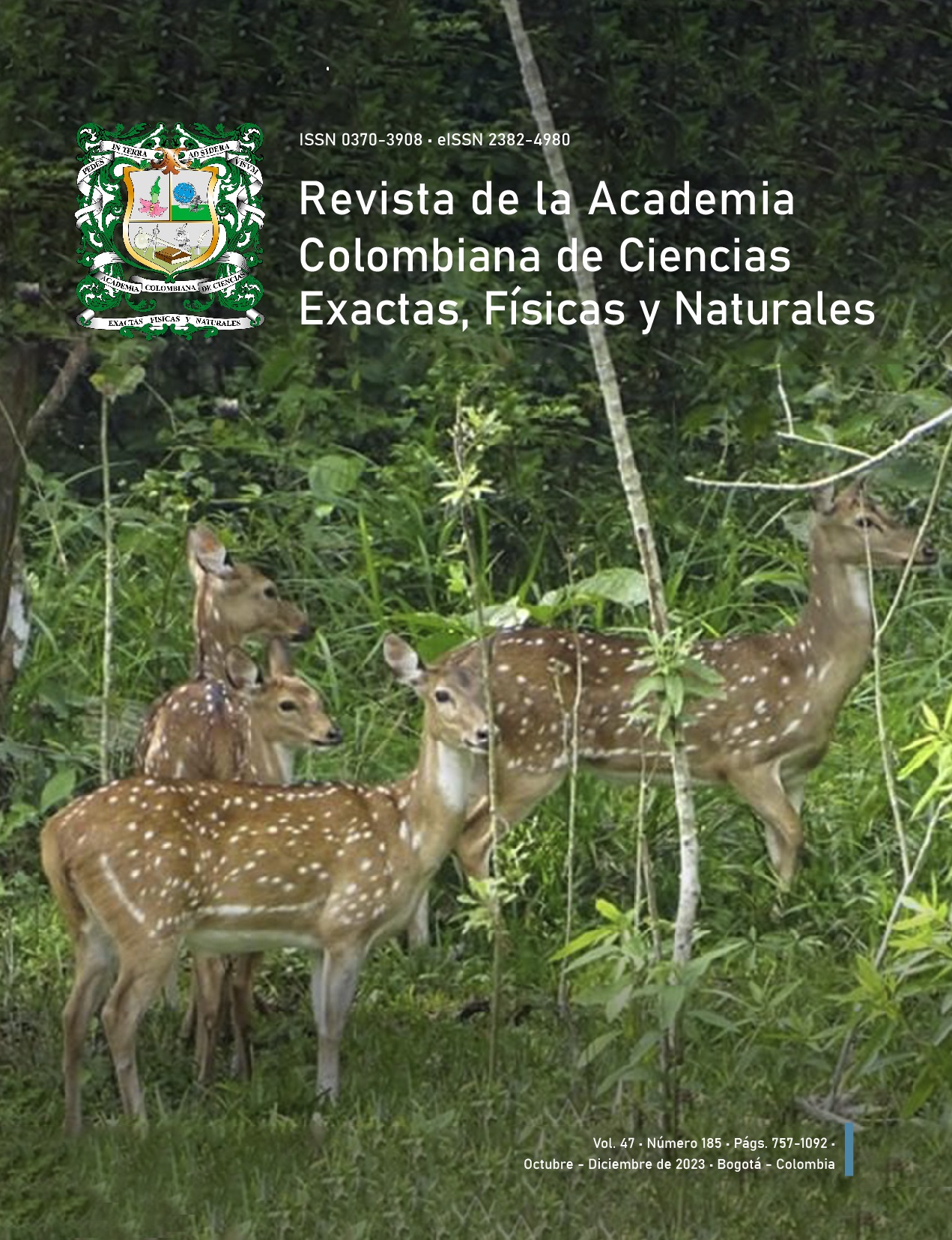Resumen
Hemos generado un marco espacial para la búsqueda de macrofósiles basado en las localidades fósiles y las capas con contenido fósil reportadas hasta hoy en la Formación Amagá localizada en los Andes noroccidentales en Colombia. Nuestros resultados muestran veintitrés localidades fósiles y noventa y cinco capas con contenido fósil que se distribuyen a lo largo de esta sucesión sedimentaria. El potencial de conservación es mayor en el Miembro Inferior debido a un mayor espacio de acomodación y al control que ejerce el predominio de un sistema fluvial meandriforme, en comparación con el Miembro Superior donde había menos espacio de acomodación y un sistema fluvial trenzado. Nuestros hallazgos muestran que a pesar de que los estudios paleontológicos son nulos en esta área, existen varias posibilidades para encontrar asociaciones de macrofósiles terrestres que permitirán investigar el posible papel biológico de los cambios climáticos globales y la tectónica regional en los biomas neotropicales de la Formación Amagá.
Referencias
Carvalho, M. R., Herrera, F., Jaramillo, C., Wing, S. L., Callejas, R. (2011). Paleocene Malvaceae from northern South America and their biogeographical implications. American Journal of Botany, 98(8), 1337-1355.
Giraldo, L. A., Labandeira, C., Herrera, F., Carvalho, M. (2021). Rich and specialized plantinsect associations in a Middle-Late Paleocene (58-60) Neotropical rainforest (Bogotá Formation, Colombia). Ameghiniana, 58(2), 75-99.
Gómez, A. A., Jaramillo, C. A., Parra, M., Mora, A. (2009). Huesser Horizon: A lake and a marine incursion in northwestern South America during the Early Miocene. Palaios, 24(4), 199-210.
Grosse, E. (1926). El Terciario Carbonífero de Antioquia. D. Reimer - E. Vohsen, Berlin.
Head, J. J., Bloch, J. I., Hastings, A. K., Bourque, J. R., Cadena, E. A., Herrera, F., Polly, P.D., Jaramillo, C. (2009). Giant boid snake from the Paleocene neotropics reveals hotter past equatorial temperatures. Nature, 457, 715-717.
Henao, J. E. (2012). Estratigrafía y Petrografía de las Areniscas de la Secuencia Quebrada La Naranjala – Municipio de Fredonia Miembro Inferior de la Formación Amagá. Undergraduate Thesis. Universidad EAFIT. 61 pp.
Hendy, A. J., Jones, D. S., Moreno, F., Zapata, V., Jaramillo, C. (2015). Neogene molluscs, shallow marine paleoenvironments, and chronostratigraphy of the Guajira Peninsula, Colombia. Swiss Journal of Palaeontology, 134, 45-75.
Ji, S., Nie, J., Lechler, A., Huntington, K. W., Heitmann, E. O., Breecker, D. O. (2018). A symmetrical CO2 peak and asymmetrical climate change during the middle Miocene. Earth and Planetary Science Letters, 499, 134-144.
Lara M., Salazar-Franco, A. M., Silva-Tamayo, J. C. (2018). Provenance of the Cenozoic siliciclastic intramontane Amagá Formation: Implications for the early Miocene collision between Central and South America. Sedimentary Geology, 373, 147-162.
Londoño, L., Royer, D. L., Jaramillo, C., Escobar, J., Foster, D. A., Cárdenas, A., Wood, A. (2018). Early Miocene CO2 estimates from a Neotropical fossil leaf assemblage exceed 400 ppm. American Journal of Botany, 105(11), 1929-1937.
Martínez, C., Jaramillo, C., Correa-Metrío, A., Crepet, W., Moreno, J. E., Aliaga, A., ... Bush, M. B. (20 autores) (2020). Neogene precipitation, vegetation, and elevation history of the Central Andean Plateau. Science Advances, 6(35), eaaz4724.
Martínez, C., Jaramillo, C., Martínez-Murcia, J., Crepet, W., Cárdenas, A., Escobar, J., Moreno, F., Pardo-Trujillo, A., Caballero-Rodríguez, D. (2021). Paleoclimatic and paleoecological reconstruction of a middle to late Eocene South American tropical dry forest. Global and Planetary Change, 205, 103617.
Montes, C., Cardona, A., Jaramillo, C., Pardo, A., Silva, J. C., Valencia, V., … Niño, H. (2015).Middle Miocene closure of the Central American Seaway. Science, 348, 226-229.
Ortiz, J., Jaramillo, C. (2020). SDAR: Stratigraphic Data Analysis. R package version 0.9-55.
Páez-Acuña, L. A. (2013). Análisis Estratigráfico y de Proveniencia del Miembro Superior de la Formación Amagá en los Sectores de La Pintada y Valparaíso (Cuenca Amagá, Andes Noroccidentales). Undergraduate Thesis. Universidad EAFIT. 165 pp.
Pekar, S. F., DeConto, R. M., Harwood, D. M. (2006). Resolving a late Oligocene conundrum: Deep Sea warming and Antarctic glaciation. Palaeogeography, Palaeoclimatology, Palaeoecology, 231(1-2), 29-40.
Pilsbry, H. A., Olsson, A. A. (1935). Tertiary fresh-water mollusks of the Magdalena embayment, Colombia. Proceedings of the Academy of Natural Sciences of Philadelphia, 87, 7-39.
R Core Team. (2021). R: A language and environment for statistical computing. R Foundation for Statistical Computing, Vienna, Austria. URL https://www.R-project.org/
Schönfeld, G. (1947). Hölzer aus dem Tertiär von Kolumbien. Abh. Senckenberg, Naturf. Ges., 475, 1-53.
Sierra, G. M., Marín-Cerón, M. I. (2011). Amagá Cauca and Patía basins. In F. Cediel (Ed.), Petroleum Geology of Colombia (pp. 1-104). Agencia Nacional de Hidrocarburos and Fondo Editorial Universidad EAFIT.
Silva-Tamayo, J. C., Sierra, G. M., Correa, L. G. (2008). Tectonic and climate driven fluctuations in the stratigraphic base level of a Cenozoic continental coal basin, northwestern Andes. Journal of South American Earth Sciences, 26(4), 369-382.
Silva-Tamayo, J. C., Lara, M., Salazar-Franco, A. M. (2020). Oligocene – Miocene Coal-Bearing Successions of the Amagá Formation, Antioquia, Colombia: Sedimentary Environments, Stratigraphy, and Tectonic Implications. In J. Gómez & D. Mateus-Zabala (Eds.), The Geology of Colombia (pp. 331-353). Servicio Geológico Colombiano, Publicaciones Geológicas Especiales 37.
Sosdian, S. M., Lear, C. H. (2020). Initiation of the Western Pacific warm pool at the Middle Miocene Climate Transition? Paleoceanography and Paleoclimatology, 35(12), e2020PA003920.
Wing, S. L., Herrera, F., Jaramillo, C., Gómez-Navarro, C., Wilf, P., Labandeira, C. C. (2009). Late Paleocene fossils from the Cerrejón Formation, Colombia, are the earliest record of Neotropical rainforest. PNAS, 106(44), 18627-19632.
Woodring, W. P. (1957). Geology and Paleontology of Canal Zone and Adjoining Parts of Panama. United States Survey Professional Paper, 306(A), 1-145.

Esta obra está bajo una licencia internacional Creative Commons Atribución-NoComercial-SinDerivadas 4.0.
Derechos de autor 2023 Revista de la Academia Colombiana de Ciencias Exactas, Físicas y Naturales

